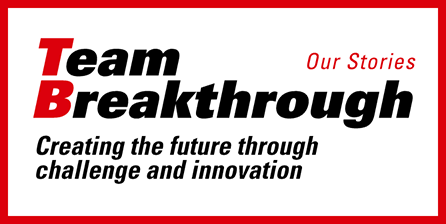Response to the TNFD
Toyota Boshoku group formulated the 2050 Environmental Vision in 2016. And we reviewed the Toyota Boshoku group's past activities and our future target and in July 2023 drew up three key initiatives. We analysed nature-related risks and opportunities to understand nature dependencies and impacts of our group business and further three key initiatives: measures to global warming prevention in response to climate change, circular economy in response to the depletion of natural resources, and co-existence with nature in response to the biodiversity crisis. In future, we will disclose our information based on Taskforce on Nature-related Financial Disclosures (TNFD) framework. We aim to further contribute to global environmental conservation.
Governance
Concrete measures related to climate change, the depletion of natural resources, the biodiversity crisis and other environmental issues are decided upon by the Board of Directors and implemented. Then these measures will be reviewed at the Corporate Strategy Meeting, the Corporate Planning Meeting, and the Corporate Management Meeting.
Policies and plans to respond to environmental issues identified by the Board of Directors, the Corporate Strategy Meeting, and the Corporate Planning Meeting are shared at the Environment Promotion Meeting, which is held three times annually, and is connected with implementation planning and progress management for environmental issues affecting the Toyota Boshoku group. Additionally, KPIs are created based on implementation planning, and these are reported and subjected to management review at monthly Corporate Management Meetings.
Matters reported and discussed upon at the Environment Promotion Meeting are reported to the Board of Directors as needed, whose directions and supervision allow such matters to be incorporated into group strategy.
Furthermore, the Human Rights Working Group is conducting activities, with the CSO (Chief Strategy Officer) in charge of Corporate Planning Segment as the leader. The Corporate Planning Division serves as the secretariat, and members are elected from the HR, purchasing, general administration, legal, and safety-related divisions.
The Human Rights Working Group organizes the approach to human rights, identifies human rights risks, and discusses initiatives, etc. Reports on the Group’s activity plans, progress, and results are made to the CSV Promotion Meeting, and reported to the Board of Directors, which discusses and makes confirmations, chaired by the Chairman.
Strategy
Analysis Process
We analysed by LEAP approach of TNFD framework.
| Locate Identify priority region |
Evaluate Grasp dependencies and impacts |
Assess Assess risks and opportunities |
Prepare Prepare action and disclosure |
|---|---|---|---|
| We narrowed down priority region of direct operations based on TNFD five standards. (Conservation significance, Ecosystem integrity, Low integrity, Water stress, Nature dependencies and impacts) | We identified nature dependencies and impacts key initiatives of each supplychain including upstream, direct operations and down stream by using ENCORE*1 which is TNFD recommendation tool. | We identified and assessed risks and opportunities of each supplychain including upstream, direct operations and down stream based on identified dependencies and impacts by two factors:impact and potential. | We connect our group business strategy and action with identified risks and opportunities. Then we organized it. This time we disclosed analysed result. |
- Exploring Natural Capital Opportunities, Risks and Exposure: The assessment tool of nature-related which is developped by The UN Environment Programme World Conservation Monitoring Centre(UNEP-WCMC)and Natural Capital Finance Alliance(NCFA)etc.
Analysis result
We wrote high assessment result of nature-related risks and opportunities in the table below.
| Causes | Impact stage | Classification | Risks / Opportunities | Actions |
|---|---|---|---|---|
| Increased importance of sustainable raw material procurement | Procurement | Risk |
|
|
| Opportunities |
|
|
||
| Enhancement of nature-related policy | Direct operation | Risk |
|
|
| Opportunities |
|
|
||
| Change in evaluation by customers and the consumer value standard (raised environmental awareness, etc.) | Product demand | Risk |
|
|
| Opportunities |
|
|
||
| Worsening of extreme weather, including shortage of water and flooding | Procurement | Risk |
|
|
| Direct operation |
|
|
Risk Management
Nature-related risks are deliberated upon at the Risk Management Promotion Meeting, with the CHRO(Chief Human Resources Officer), head of the Human Resources & General Administration Segment acting as chairperson.
The Risk Management Promotion Meeting receives reports from various departments, and discusses risks of all kinds, such as environmental pollution and nature disasters. Judgments are made concerning the relative severity of risks, with consideration made to the relationship between various risks. Finally, risks which affect the entire company are identified.
Identified risks are reported to the Board of Directors, under the management of the CRO (Chief Risk Officer) who is also the President.
Metrics and Targets
| D e p e n d e n c y ・ I m p a c t |
Classification | TNFD core metrics(Disclosure unit) | Contents | FY24 Results | FY26 Targets | FY31 Targets |
|---|---|---|---|---|---|---|
| Land-use change | Total spatial footprint (km2) | Number of trees planted | Cumulative 700k |
Cumulative 640k |
Cumulative 770k |
|
| Extent of land/freshwater/ocean-use change (km2) | Water consumption reduction ratio (compared to FY2014) | ▲37% | ▲6% | ▲8% | ||
| Water resources overall quantity released* | 3,415,000m³ | - | - | |||
| Pollution | Pollutants released to soil split (t) | Quantity of substances falling under PRTR* | 515t | - | - | |
| Waste generation and disposal (t) | Waste emissions reduction ratio (compared to FY2012) | ▲9% | ▲14% | ▲20% | ||
| Waste overall volume* | 30,138t | - | - | |||
| Waste Basic unit* | 3.52t/thousand units | - | - | |||
| Reverse compensation recycling* | 15,815t | - | - | |||
| Incinerated waste* | 6,538t | - | - | |||
| Direct landfill waste* | 7,784t | - | - | |||
| Wrapping, packaging materials used* | 2,049t | - | - | |||
| Non-GHG air pollutants (t) | NOx* | 15.5t | - | - | ||
| SOx* | 0t | - | - | |||
| Quantity of substances falling under PRTR* | 515t | - | - | |||
| VOC substances* | 428t | - | - | |||
| Resource use | Water withdrawal and consumption from areas of water scarcity (m³) | Water resources overall quantity released* | 3,415,000m³ | - | - |
- Please see detail on ESG Data page





